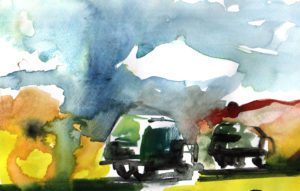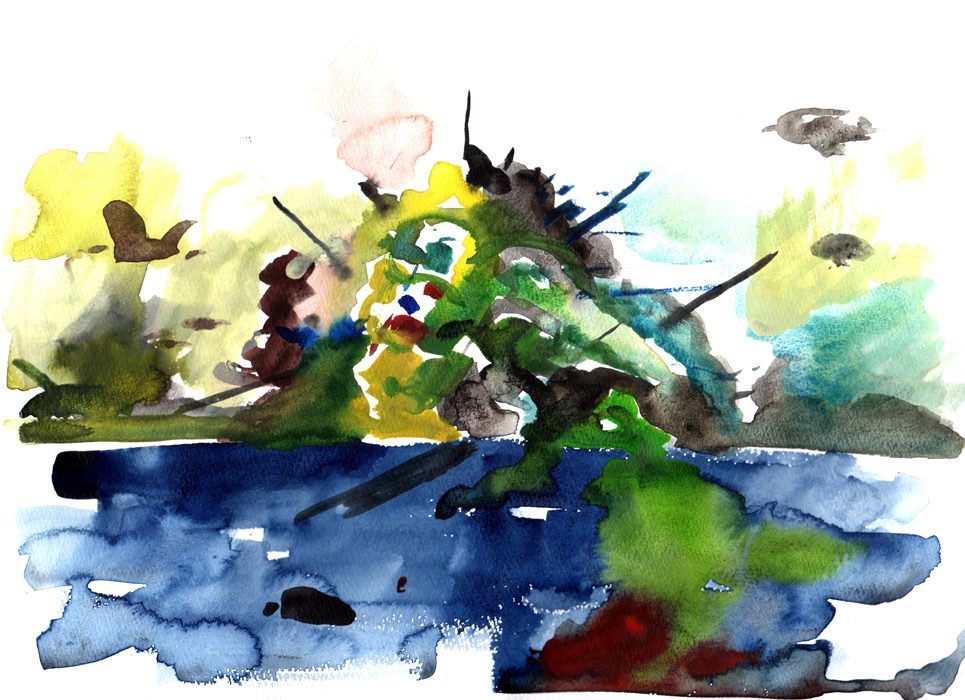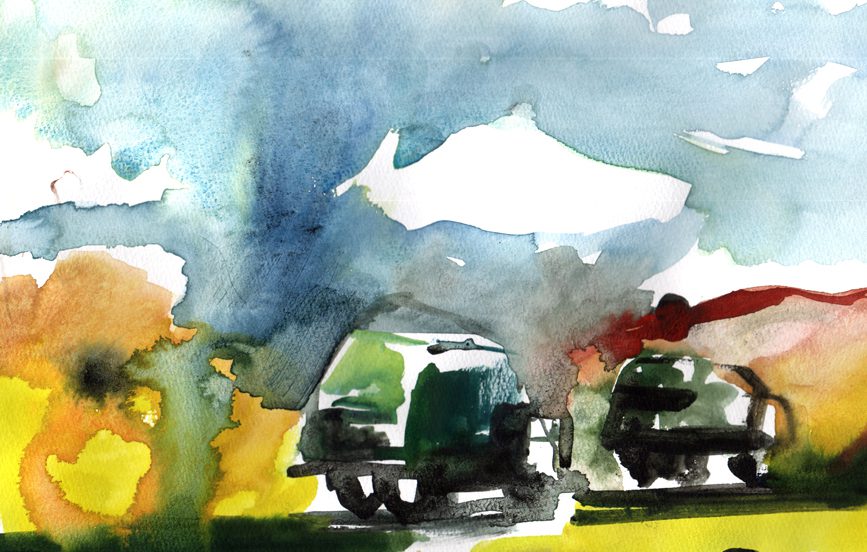
You think water is a California apocalyptic obsession: Jack Nicholson and his slashed nose in Chinatown. After all, a fourth of the state is actual desert, the Mohave’s drought creeping up to the lettuce-y part. Or maybe you think the big water problem is in Flint with its lead poisoning, or far, far away in India where Coca Cola tries to siphon off every available ounce. But no, the most devastating water disaster in the world is in the Midwest, and it’s invisible. Deep underneath our nation’s breadbasket sits the Ogallala aquifer, one of the world’s largest underground reservoirs—but not for long. A pivot sprinkler system invented in the 1960s has been pumping out its water at the incredible rate of thirty gallons a minute. In some places, the aquifer water table has dropped two hundred feet in a year, and it’s still dropping. The acreage above the aquifer—most of Nebraska, Kansas, Oklahoma, New Mexico, Colorado, Wyoming, and parts of Texas—is known for its irrigated bumper crops of thirty-five billion dollars per year. You think bees are a problem in our food chain? It’s not a coincidence that two hundred years ago the area was labeled the Great American Desert.
Scientists have been warning farmers about the aquifer’s disappearance for decades, but farmers have gambling blood. Who else borrows to the hilt at the bank every year, and then waits to see if they’re going to be wiped out in a ten-minute hail storm? No focus group helps determine which crop would be best, or when to plant, or how much water to use. Farmers invented climate fiction, stories that console or haunt or condemn them to the whims of the weather. For the rest of us, climate fiction delivers the news that the pitter patter of water is not just backdrop, it’s the character that changes everything.
The term climate fiction or the snazzier cli-fi was coined in 2008 by journalist Dan Bloom and popularized by NPR five years later. Water has always been a major theme, usually too much of it. In the 1960s, J. G. Ballard wrote a trilogy that began with The Drowned World, featuring a Max Ernst-like landscape to reflect a surreal city beneath the waves. New York 2140, published by Kim Stanley Robinson in 2017, dramatizes what New York City would be like half-submerged. Margaret Atwood wrote The Year of the Flood in 2009, the second book in a trilogy about climate, and T.C. Boyle’s A Friend of the Earth, published in 2000, envisions the near future flood-ravaged and famine-stricken. But when it’s raining in Illinois, it’s dry in Montana. Drought is always the flip side. Because drought is more subtle than flooding—day after day of no rain—it’s a less tempting subject.
Creeping change is what keeps people from acknowledging disaster. Publishing Solar in 2010, Ian McEwan said of skeptics: “I think just talk to a salmon fisherman, if you don’t want to talk to scientists. Go talk to a ski-lift operator in Switzerland.” Slow acceptance, and the inability to take responsibility also stands in the way. But human activity has always been changing climate. A recent study shows the extermination of sixty million Native Americans in the sixteenth and seventeenth centuries caused the Little Ice Age in Europe. So much acreage had been taken out of cultivation that the CO2 levels dropped, and seventy-five million Europeans starved to death as a result of yearlong winters. Had their rulers known the consequences, would they have preferred to let the Native Americans cultivate, or at least share the land?
In terms of sharing, the Great American Desert was not all that attractive. As Black Elk put it: “If I even thought your hearts bad enough to take this land, I would not fear it, as I know there is not wood enough on it for the use of the whites.” Flat, treeless and arid, the explorer Major Long decided on its name in 1820, disgusted and impatient with its aridity and ignoring the prairie grass that flourished on it, despite having no apparent water source. At the center of this so-called desert lay the Nebraska Sandhills, an ocean of grass, with dunes lightly covered with brush.
The largest town near the Sandhills is Ogallala, which means “to scatter one’s own” in Oglala Lakota. A geologist in the 1940s named the aquifer after it. Lack of water in the area forced the Oglala to scatter their ponies and villages, and by doing so, they honored the land’s environmental constraints. Later, homesteaders, starved and thirsty and stranded, had no choice but to dig wells deep into the prairie grass. My father served as director of the district water board seventy years later, advising and adjudicating the use of its wells. If farmers had their share of irrigated water reduced by the nesting of sandhill cranes, they threatened to shoot them down. It’s not wind and sun that chaps Manifest Destiny’s Midwestern red neck, it’s limitation.
Humans have never been long-range planners, except out of narcissism: the Cheops. We lean more toward the short term: Snapchat. It’s about as easy to imagine Persephone wandering around under our feet with a pomegranate as it is to think of all that invisible water being finite. Was it ever meant to be used, or was it a reserve, available only for the direst of circumstances? This fossil water is certainly precious: to replace it will take six thousand years. But by pumping it up, isn’t it then put it back into circulation? That’s the way solarpunk authors would spin it, those who put the earth’s future in a positive light. But what about the Dust Bowl in our past?
Poison now snakes into what’s left of the water. Plastic micro-fragments are being pumped up, along with discarded barbiturates and sleeping pills and cancer-producing chemicals from various Superfund sites that dot the aquifer’s map. Pig effluent (such a pretty word) threatens further poison. Twenty years ago, my sister, an attorney, endured four years of a slap suit because she represented farmers suing local pig producers who didn’t process their shit. A slap suit is one that allows her opponent, a big corporation, to take away all her assets— and her clients’—if they can prove libel. Her savings for college, her house, her car— everything she owned—was at risk. Fortunately, she won. A few years later, she noticed a caravan of a thousand dump trucks wending their way from South Dakota to Nebraska. As an environmental attorney, she knew the Army liked to repair their bombs in the remotest parts of the world, not only in the South Pacific and in the deep South, but also in the seemingly empty plains of South Dakota, where the Black Hills Army Depot was being decommissioned. Since the governor of South Dakota had previously held a position at Waste Management Inc., the largest company of waste disposal in the world, he arranged to send these trucks filled with “reconditioned” soil to an even more remote southerly location: southwest Nebraska, coincidentally the center of the Ogallala aquifer.1
This treatment did not take into consideration the sarin, chemical weapons, rocket fuel, and mustard gas present in that contaminated area. The local dump had just been upgraded to accept waste ten percent more toxic than South Dakota’s, and put down thin plastic sheeting between the waste and the aquifer. Witnesses saw the bulldozer rip portions of it to shreds. A hearing was held, and the farmers were allowed to comment, but all everyone received was a copy of the proceedings three weeks later. Dumping chemicals has always been at the expense of the poor, and at that time, the poorest people in America lived around Ogallala. However, some on the city council made money, having invested in the dump’s upgrade. Poisons in the aquifer will eventually kill the crops, if not the population, producing a die-off—which may indeed correct the climate problem. Parts of the original South Dakota location have already been turned into a survivalist camp.
The real irony is that increased CO2 has produced phenomenal crops across the Great American Desert. Why would farmers want to shut off their sprinklers? This is where climate fiction becomes essential. Even if cli-fi does rhyme with sci-fi, it doesn’t have to be speculative. Actual circumstances are becoming more surreal every day. So often degradation is invisible and slow, especially the kinds people in power don’t want known: not just the fresh water evaporating invisibly over our ethanol corn but the creeping accumulation of plastic that has made continents floating in each of our oceans. It’s easy to suggest some cataclysm in 2030 is going to catapult us into overwhelming disaster; it’s more challenging to reveal that what we’ve been doing all along is dangerous—and stop it. Otherwise all we can do is hope for is some cowboy Laurence of Arabia to do battle with the sheikhs parading their camels through the sandy romance of the Midwestern future. Few know that camels evolved there, twenty-three varieties in Nebraska alone. When the weather turned, they left to walk over the Bering Strait. Perhaps they’ll be back.
***
1. Graham, Frank L. “Dirty Business: Answers to Landfill Questions are Few.” North Platte Telegraph, 27 Feb 2002.↩
***
Rumpus original art by Dmitry Samarov.







